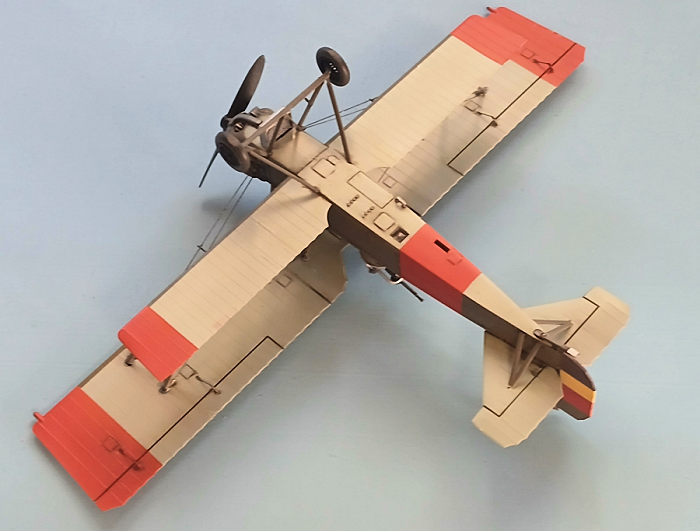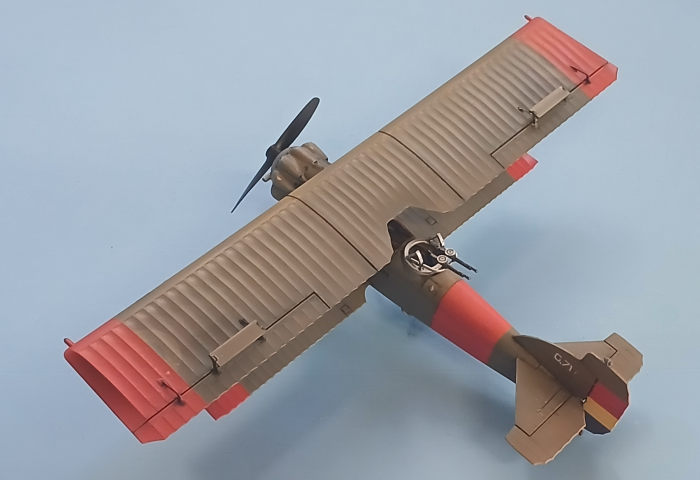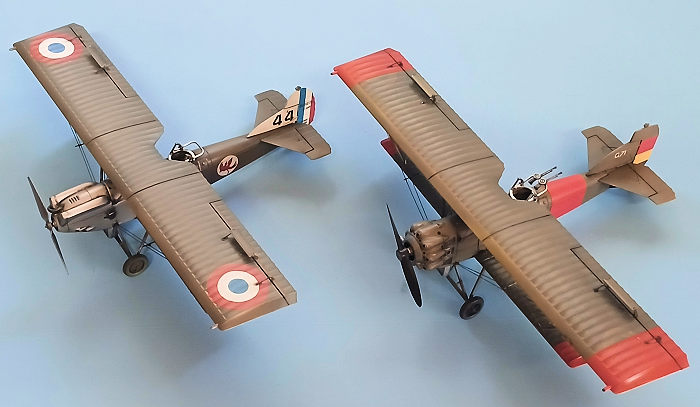
Azur/FRROM 1/72 Potez 25 Salmson 18CMb
| KIT #: | FR0054 |
| PRICE: | $ |
| DECALS: | Three options |
| REVIEWER: | Ryan Grosswiler |
| NOTES: | 2024 release. High-end limited run, photoetch |

| HISTORY |
Largely disregarded today, the Potez 25 was in reality one of the most impressively successful airplanes in aviation history. In an era where a couple hundred airframes manufactured would constitute a major production order, the big wood-and-fabric biplane was built in the several thousands (the exact figure being unknown) and exported to dozens of nations. Manufactured with simple technology and adaptable to any powerplant of the time within a certain horsepower range, the design through license production allowed several foreign countries to expand their own aviation industries, and by the end of the 1920s the Potez was in widespread service everywhere around the globe except North America.
As the 1930s progressed
and the aeronautical state-of-the-art moved on to metal monoplanes, this
probably would have been the end of the story of the
versatile design
had it not been for a series of global tensions that were about to ignite
into a series of small wars, and eventually a Rather Large One. In
reflection of the general trend, those in Spai n
were centered on an increasing divide between the rabble on the political
left and the rabble on the political right. Inflamed by crazed rhetoric on
both sides (sound familiar?), the nation split tragically in two along
localized areas, with the rebelling, traditionalist-fascist-oriented
Nationalists generally in control of areas in the west and south of the
country and the leftist-libertine Republicans, patches to the north and
east.
n
were centered on an increasing divide between the rabble on the political
left and the rabble on the political right. Inflamed by crazed rhetoric on
both sides (sound familiar?), the nation split tragically in two along
localized areas, with the rebelling, traditionalist-fascist-oriented
Nationalists generally in control of areas in the west and south of the
country and the leftist-libertine Republicans, patches to the north and
east.
When Nationalist rebellion broke out into full-scale civil war during July 1936, a pair of Spanish Republican officers were already present in Paris to request assistance. With them they had a list of desired military equipment, and at the top was the French Potez 540 bomber. Providing such a large multiengine airplane was viewed as too conspicuous this early in the conflict, and complicating the matter was the general European policy of supposed non-intervention. The French therefore came up with a convoluted and top-secret counter-offer: 17 Farman-powered Potez 25s in warehouse storage were offered to Spain instead. The way the deal was supposed to work is that the Marcel Bloch company was to purchase the aircraft and deliver them straight to Spain, with the company handing the Spanish payment back to the French government under the guise of a penalty for non-fulfillment of a fictitious order of Bloch MB.132 bombers. Thus goes the way of formalized money laundering.
The gambit might have worked if the Spanish officers hadn't discovered that the Potez 25s presented to them were mostly in a non-airworthy condition, apparent even disassembled and crated. The story percolated into the French press, causing a scandal. However, the more disorganized, philosophically-confused Republican forces then began what was to be their general direction of the Civil War: a steady loss of territory. Suddenly, non-airworthy airplanes were better than no airplanes, and the first of what was to ultimately be about two-dozen Potez 25s arrived in Spain, the Salmson-powered example depicted here arriving among the later batches. All were reworked. Most had been in French civilian service prior to going into storage, and along with the general deep overhaul to get them flying again they got their guns back. Put into patrol work over the north of the country, all were destroyed by the end of the fighting in 1939.
Yes, that's a coolant radiator hanging beneath that round nose. The CMb version of the Salmson 18 engine was, peculiarly, a liquid-cooled radial, resulting in the sub-type's distinctly Flash Gordon-looking front end.
| THE KIT |

| CONSTRUCTION |
I had obviously learned quite a bit about this kit with my other Potez 25 build earlier this summer, and these lessons were applied. I spent more time beveling the edges between the fuselage bottom and sides, ultimately removing about .025 mm from both joints. The parts (and the lower wing later on) therefore fit better this time around. As I wanted to do a Spanish Civil War machine, I painted and fitted the cockpit a little in contrast to the first build to reflect a different time, locale, and usage. Holes on the lower wing for the bomb racks were once again filled and sanded, with the resulting lost rib taping detail restored through the same process as before.
As with the first build, I was
pleasantly surprised at how well the assembled forward fuselage fit to the
corresponding aft. I normally build my kits engineered this way differently,
preferring to glue fore-aft fuselage pieces to each other b efore
assembling left-right. This avoids potential fit issues, but this particular
kit's engineering doesn't allow this option because the lower wing and forward
cabane strut set need to be slipped into the fore-aft joint beforehand.
efore
assembling left-right. This avoids potential fit issues, but this particular
kit's engineering doesn't allow this option because the lower wing and forward
cabane strut set need to be slipped into the fore-aft joint beforehand.
Those cylinder head fairings held me up a bit. They're molded individually and follow a triple-compound curve. Fit isn't that great, and all seven parts required a line of filler around their bases. I don't see how Azur could have engineered this area differently, but the requisite filling-sanding-priming-repeat mantra which followed delayed completion by a couple weeks. The propeller isn't the neat press-fit as it was with the Renault version either, so a sleeved brass tube arrangement was cobbled up.
Tires (Part B6) are still out-of-round owing to a mold mismatch, which compounded the problems already inherent in assembling the photoetch wire wheels. To fit the finished wheels, Step 31 would have you cutting off the plastic axles on Part D25 and replacing them with brass rod glued into shallow holes drilled into the ends of the tiny part. This is asking for trouble as that arrangement won't bear any weight. I instead glued a spanwise piece of brass rod to the leading edge D25 after first sanding said leading edge flat. I then encased this assembly in more cyanoacrylate glue, sanding it to a uniform airfoil shape when it had cured, then assembling otherwise per instructions. With a single axle running wheel to wheel, it's much stronger. Again, the Messier-type landing gear is molded outside the sprue perimeter and suffered consequent damage, so required repair before assembly.
| COLORS & MARKINGS |
I intentionally wanted this model to contrast with the peacetime French example that I built earlier this summer, hence the Spanish Republican markings and configuration. Having fitted the struts but not the top wing, I sprayed the whole model with variations of RLM 65 underneath, masked, followed by RLM 70 up top. The Spanish national colors were applied to the rudder and masked off. The French roundel decals were then slid into place on the top side of the wing, then all upper surfaces were sprayed with a more olive-colored green until the roundels were barely showing, but definitely still there. The red-orange wingtips and fuselage band were then masked and sprayed. I have no idea if these Spanish machines sported this sort of see-through effect to the old national markings, but I wanted to experiment and it looked cool.
 Here I ran into
another delay. A wildfire which had been burning on other side of the mountains
experienced a rapid change in favorable wind and humidity, and suddenly tore out
of control and jumped three ridges, advancing 17 miles in 45 minutes. As the
local warning went from 'No Danger' to 'Evacuate' to 'Drop What You're Doing Get
In the Car And Leave NOW!!!' in the space of about half an hour, we had to get
the kids and dogs out with a few changes of clothing and some financial records.
Then we had to help an elderly recent amputee neighbor into the car along with
his colostomy bag. As we were pulling out of town, propane tanks were exploding
at houses a few blocks to the west. Clearing out from under the massive smoke
plume and separated from the danger, among the many other things that run
through one's mind with the probability of
losing one's home and everything in it came the thought: does my modeling life
continue after this?
Here I ran into
another delay. A wildfire which had been burning on other side of the mountains
experienced a rapid change in favorable wind and humidity, and suddenly tore out
of control and jumped three ridges, advancing 17 miles in 45 minutes. As the
local warning went from 'No Danger' to 'Evacuate' to 'Drop What You're Doing Get
In the Car And Leave NOW!!!' in the space of about half an hour, we had to get
the kids and dogs out with a few changes of clothing and some financial records.
Then we had to help an elderly recent amputee neighbor into the car along with
his colostomy bag. As we were pulling out of town, propane tanks were exploding
at houses a few blocks to the west. Clearing out from under the massive smoke
plume and separated from the danger, among the many other things that run
through one's mind with the probability of
losing one's home and everything in it came the thought: does my modeling life
continue after this?
However, the firefighters of various agencies worked intelligently and the blaze was halted—no joke—fifty yards from my front door. After ten days out my home, model life did in fact continue along with the rest of the household. Finished colors were protected on this model under a couple coats of Gunze clear semigloss, and a wash and dry brush followed. The top wing was then glued in place and the model rigged with .002 steel wire. The wheels, aileron booster tabs, and dorsal gun ring were attached, and she was done.
| CONCLUSIONS |
Find a better set of wheels if you can. Not quite the joyride of the Renault version owing to lots of extra work associated with those cylinder head fairings, the photoetch wheels compounding the problems with the mold mismatch, the axle fit, and prop mounting. Nonetheless I still enjoyed this build, as the peculiar look of that liquid-cooled radial made it worthwhile. I'll be returning to the base kit for a Yugoslav and maybe Greek version at some point.

| REFERENCES |
If you can find it, for something like a reasonable price...
Kulikov, Victor. Potez 25. Avions—Lela Presse. ISBN 978-2950948502
Otherwise...
The Internet
Back to the Previews Index Page
Back to the Previews Index Page